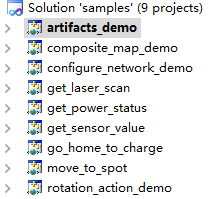本页介绍了artifacts_demo的用法, 包含虚拟墙/虚拟轨道的删除,添加与移动功能。
本页内容
运行环境准备
软件平台
- Visual Studio 2010 SP1
- Slamware Windows SDK:Slamware Windows SDK
- RoboStudio(用于显示地图):Robostudio installer
Sample Code:
使用更高版本的Visual Studio可能会带来编译异常。
使用Visual Studio 2010(无SP1)可能会因为无法与.Net Framework兼容而报编译错误,此时增加SP1更新包即可解决问题
硬件平台
(以下任选其一)
- Slamware SDP mini
- Slamware 套装 (基于Slamware导航方案的用户机器人系统)
- Apollo/Ares/Athena等底盘系统
编译运行
- 打开samples工程,右键artifacts_demo, 将此工程设置成StartUp project
右键artifacts_demo, 打开属性选项,将Slamware SDK 的include目录和lib目录添加到工程
Slamware SDK的include和lib目录无需复制到参考例程目录,只需在Visual Studio里指定路径即可。
- 右键artifacts_demo, 在Debugging页面中command Arguments处输入 192.168.11.1
格式说明:artifacts_demo <IP address> - 点击F5运行
- 此时RoboStudio的显示过程为
- Console输出为
- 选择console中输出的虚拟轨道ID来删除一条轨道,视频中输入ID为3
代码描述
- 删除所有虚拟墙/虚拟轨道
删除所有虚拟轨道/虚拟墙
SlamwareCorePlatform sdp = SlamwareCorePlatform::connect(argv[1], 1445);
std::cout << "Clearing existing tracks and walls..." << std::endl;
sdp.clearLines(ArtifactUsageVirtualTrack);
sdp.clearLines(ArtifactUsageVirtualWall);
- 添加虚拟墙
添加虚拟墙
std::cout << "Adding virtual walls..." << std::endl; std::vector<Line> walls; //add a 8 * 8 virtual wall square walls.push_back(Line(Point(-4, -4), Point(-4, 4))); walls.push_back(Line(Point(-4, 4), Point(4, 4))); walls.push_back(Line(Point(4, 4), Point(4, -4))); walls.push_back(Line(Point(4, -4), Point(-4, -4))); sdp.addLines(ArtifactUsageVirtualWall, walls);
- 添加虚拟轨道
添加虚拟轨道
std::cout << "Adding virtual tracks..." << std::endl; std::vector<Line> tracks; //add a 2 * 2 virtual track square tracks.push_back(Line(Point(-1, -1), Point(-1, 1))); tracks.push_back(Line(Point(-1, 1), Point(1, 1))); tracks.push_back(Line(Point(1, 1), Point(1, -1))); tracks.push_back(Line(Point(1, -1), Point(-1, -1))); sdp.addLines(ArtifactUsageVirtualTrack, tracks);
- 移动虚拟墙(移动虚拟轨道用法类似)
移动虚拟墙
std::cout << "Moving vitual walls..." << std::endl;
//sleep 5 seconds for displaying purpose only, not necessary
boost::this_thread::sleep_for(boost::chrono::milliseconds(5000));
std::vector<Line> get_walls = sdp.getLines(ArtifactUsageVirtualWall);
//shrink virtual wall square from 8 * 8 to 6 *6
for (std::vector<Line>::iterator it = get_walls.begin() ; it != get_walls.end(); ++it) {
it->startP().x() *= 0.75f;
it->startP().y() *= 0.75f;
}
sdp.moveLines(ArtifactUsageVirtualWall, get_walls);
- 删除指定虚拟轨道(删除指定虚拟墙用法类似)
删除指定虚拟轨道
std::cout << "Get all tracks..." << std::endl;
std::vector<Line> get_tracks = sdp.getLines(ArtifactUsageVirtualTrack);
for (std::vector<Line>::iterator it = get_tracks.begin() ; it != get_tracks.end(); ++it) {
std::cout << "ID: " << it->id() << std::endl;
std::cout << "Start from (" << it->startP().x() << " , " << it->startP().y() << ") " << "to ("
<< it->endP().x() << " , " << it->endP().y() << " ) " << std::endl;
}
std::cout << "Delete track by ID, please enter track ID:" << std::endl;
int id;
bool is_found = false;
std::cin >> id ;
for (std::vector<Line>::iterator it = get_tracks.begin() ; it != get_tracks.end(); ++it) {
if (id == it->id()) {
sdp.removeLineById(ArtifactUsageVirtualTrack, id);
is_found = true;
break;
}
}
if(!is_found)
std::cout << "Wrong ID" << std::endl;



